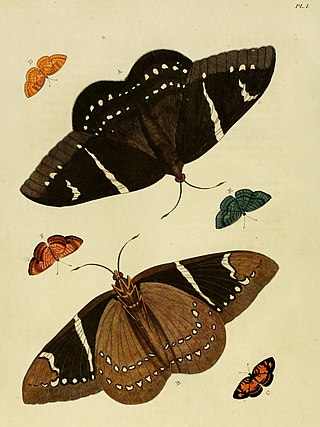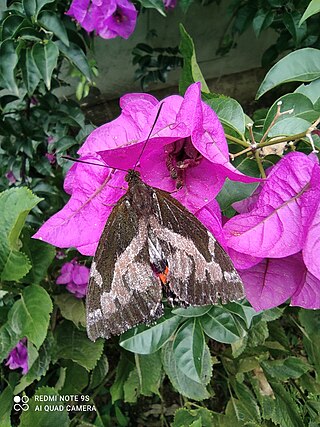
Castniidae, or castniid moths, is a small family of moths with fewer than 200 species: The majority are Neotropical with some in Australia and a few in south-east Asia. These are medium-sized to very large moths, usually with drab, cryptically marked forewings and brightly coloured hindwings. They have clubbed antennae and are day flying, and are often mistaken for butterflies. Indeed, some previous classification systems placed this family within the butterflies or skippers. The Neotropical species are commonly known as giant butterfly-moths, the Australian and Asian species as sun moths. The larvae are internal feeders, often on roots of epiphytes or on monocotyledons.

Eupalamides is a genus of moths within the family Castniidae. It was described by Constant Vincent Houlbert in 1918.

Xanthocastnia is a genus of moths within the family Castniidae containing only one species, Xanthocastnia evalthe, which is widespread in the Neotropical realm, ranging from southern Mexico to southern Brazil.

Synemon parthenoides, the orange-spotted sunmoth or link moth, is a moth in the Castniidae family. It is found in Australia, including Victoria, Western Australia and South Australia.
Synemon selene, the pale sun-moth, is a moth in the Castniidae family. It is found in Australia, including Victoria and South Australia.
Eupalamides guyanensis is a moth in the Castniidae family. It is widely distributed in northern South America, from Venezuela to Guyana, Colombia and Brazil (Pará).
Castnia invaria is a moth in the family Castniidae. It is found in South America.
Athis therapon is a moth in the family Castniidae. It is found in Brazil. It was once introduced to New Jersey.

Imara pallasia is a moth in the Castniidae family. It is found in south-eastern Brazil. It is found along cloud forests.

Imara satrapes is a moth in the Castniidae family. It is found in Brazil, Paraguay and Uruguay.

Geyeria decussata is a moth in the Castniidae family.
Corybantes pylades is a moth in the Castniidae family. It is found in Suriname, Brazil (Amazonas) and French Guiana.

Corybantes veraguana is a moth in the Castniidae family. It is found in Panama, Colombia and Ecuador.
Zegara personata is a moth in the Castniidae family. It is found in Colombia and Ecuador.
Mirocastnia pyrrhopygoides is a moth in the Castniidae family. It is found in Ecuador, Peru and Colombia.
Mirocastnia canis is a moth in the Castniidae family. It is found in Peru.
Eupalamides cyparissias is a moth in the Castniidae family. It is widespread in the Amazon basin including Peru, Colombia, Ecuador, Venezuela, Brazil, the Guianas, Suriname and north to Panama.
Eupalamides geron is a moth in the Castniidae family. It is found in Brazil.
Haemonides cronis is a moth in the Castniidae family. It is found in Mexico, Trinidad, Suriname, French Guiana, Brazil and Peru.
Lapaeumides zerynthia is a moth in the Castniidae family. It is found in Brazil, in the Neotropical realm. This species is likely found in lowland tropical forests, but future research is needed to confirm this.







